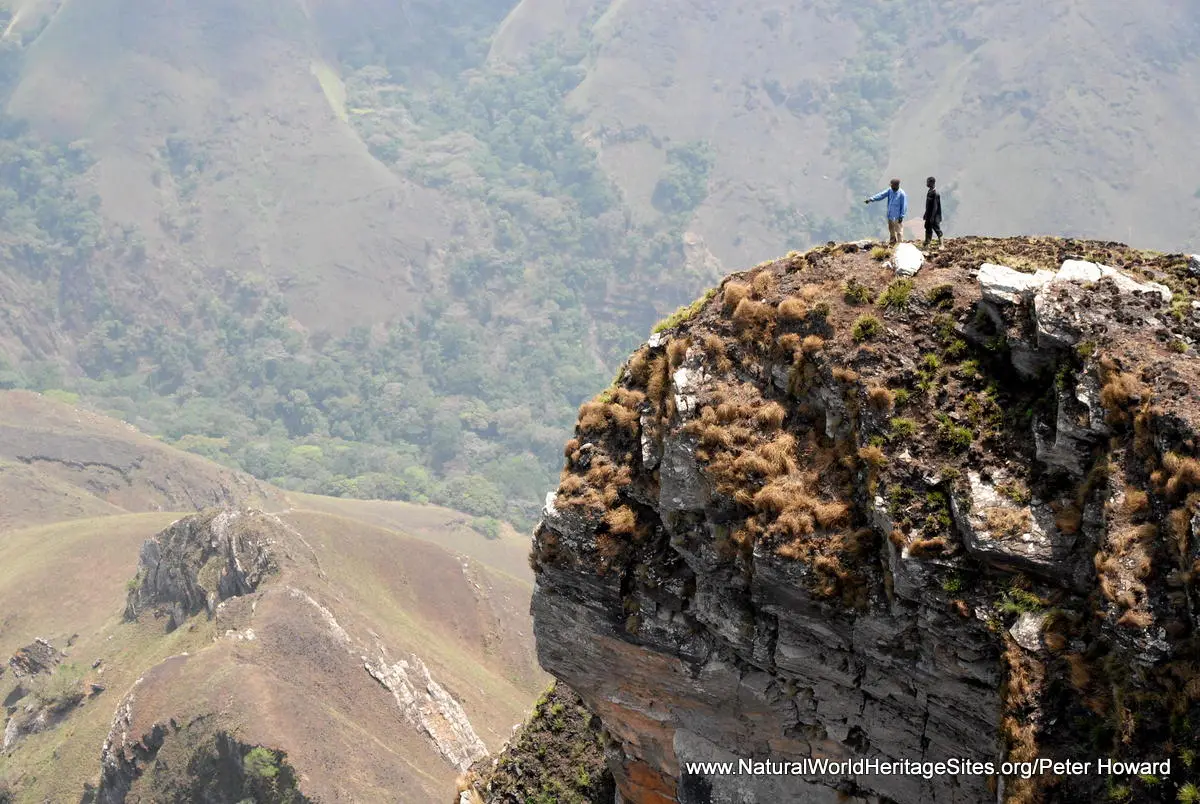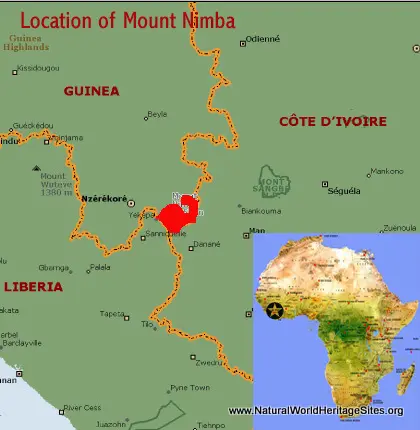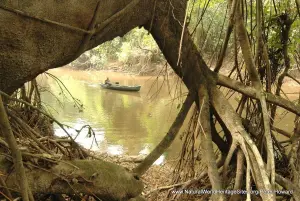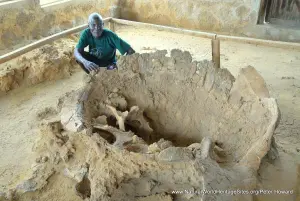EXPLORE THE MOUNT NIMBA STRICT NATURE RESERVE with this slideshow, check the location map and get all the facts and information below.
For slideshow description see right or scroll down (mobile). Click to view slideshow
Values: The Mount Nimba range rises abruptly from the surrounding plains to an altitude of 1752m, the highest point in West Africa. Its location and isolation from other mountains has resulted in the evolution of many endemic or near-endemic species, especially amongst the fauna and flora of the high altitude grasslands. Part of the range is protected as a trans-boundary reserve between Guinea, Côte d’Ivoire and Liberia, supporting an exceptional variety of forest and savanna habitats and biodiversity. But its protected status is compromised because the range contains some of the highest grade iron ore in the world, and mining interests have taken precedence in the Liberian sector and resulted in an extensive excision on the Guinean side.
A comprehensive review of the world heritage values of the site is provided below, together with details of the area’s conservation status and the threats it faces.
REVIEW OF WORLD HERITAGE VALUES: According to IUCN’s Conservation Outlook Assessment (2014), the specific attributes which qualify Mount Nimba Strict Nature Reserve for world heritage status can be summarised as follows:
Exceptional diversity of flora and fauna. Mount Nimba is one of the most biologically diverse areas in West Africa with more than 317 species of vertebrates (including 107 mammals), and more than 2500 species of invertebrates. The reserve also supports a very important flora, with dense tropical forest covering the lower slopes of the massif, and montane forest, rich in epiphytes, at higher elevations. The summit ridges support short-grass montane grasslands, and more than 2000 species of vascular plants have been recorded from the reserves on either side of the international border.
Large numbers of endemic species. Mount Nimba is an isolated mountain block surrounded humid lowlands, where evolutionary processes have led to the development of unique species and varieties. Most of these are little-known invertebrate and plant species but two endemic vertebrates deserve particular mention – the Mount Nimba Otter-Shrew (Micropotamogale lamottei) and the viviparous toad (Nectophynoides occidentalis). It is likely that many unique plants and animals remain to be discovered and described.
Wide variety of habitats. Mount Nimba rises steeply to an altitude of 1752 m from the humid forests of lowland West Africa. The range of altitude, and diversity of aspect and geology combine with seasonal climatic factors to create an exceptional diversity of physical environments. This gives rise to enormous local variation in microclimate and ecosystem function, with an exceptional diversity of forest, savanna, woodland and other habitats in close proximity to one another.
CONSERVATION STATUS AND PROSPECTS: Mount Nimba has been on the List of World Heritage In Danger since 1992, and continues to face numerous serious threats. The area originally nominated for world heritage status was reduced in 1993 when a substantial enclave was excised from the Guinean part of the site for the development of an iron ore mine. Mining continues to pose a major threat, not only from the direct loss of montane habitats but also secondary impacts such as the pollution of waterways, influx of people (with associated risks of poaching and other resource use), and impacts of service infrastructure. The area surrounding Mount Nimba is experiencing exceptionally high rates of human population growth, with corresponding pressures on all natural resources, extensive deforestation, high incidence of fire, poaching, wood cutting and other forms of resource use.
MANAGEMENT EFFECTIVENESS: The management capacity of the Guinean Office of Biological Diversity and Protected Areas remains very limited and highly dependent on external technical and financial support (a UNDP / GEF project is underway). Meanwhile the Ivorian side of the mountain suffered extensive agricultural encroachment during recent socio-political unrest (2002-10), when staff of the Office of Parks and Reserves (OIPR) abandoned management of the site for several years. Management on the Ivorian side is now slowly being restored, but the pressures on resources throughout the region continue to grow and the natural habitats within the reserve are becoming increasingly isolated, with severe ecological implications. There is no effective buffer zone around the site.
REVIEW OF CONSERVATION ISSUES AND THREATS: The following issues represent specific threats to the ecology, conservation and values of Mount Nimba Strict Nature Reserve world heritage site.
Mining. Mining has had a devastating impact on the Mount Nimba environment and poses the greatest continuing threat to the ecological integrity of the world heritage site. Rich iron ore deposits have been exploited from the Liberian part of the mountains, as well as the 15.5 km2 enclave that was excised from the Guinean side of the (original) world heritage site. More recently, there is renewed interest in exploration for iron and nickel in the areas immediately adjacent to the site in Guinea and Ivory Coast, and mining may soon resume in the Liberian part of the mountains. Although none of these mining activities is currently being undertaken within the officially-recognised world heritage site (following the re-alignment of boundaries in 1993), all of them have the potential to threaten its ecological integrity through pollution of waterways, habitat loss in surrounding areas leading to ecological isolation, and through the impact of immigrants attracted by the social and economic opportunities associated with mining and associated infrastructure developments.
Poaching (Illegal hunting). Poaching is one of the greatest threats to the ecological integrity of the reserves, affecting most of the larger mammals. Several species are considered especially vulnerable, including black duiker, aquatic chevrotain, royal antelope, olive colobus and Diana monkey. Hunting activity is primarily for food, with about half the catch sold in local markets.
Deforestation and Ecological Isolation. The natural habitats of the Mount Nimba reserves are becoming increasingly isolated as deforestation in surrounding areas proceeds. This has a particularly adverse impact on larger species, such as the endangered chimpanzees, which may range widely and require large areas of suitable habitat.
Fire. Fire is used by farmers (to clear and prepare land for planting) and poachers (to drive animals out of cover). Uncontrolled fires are becoming more frequent and widespread, and are likely to be affecting natural habitats within the reserves, favouring fire-tolerant woodland and grassland communities over closed canopy forest types.
Population growth, immigration and resource pressures. Human population growth around the site is high, partly due to immigration of Liberian refugees (who did not return home at the end of the Liberian war). Population growth results in rapid clearance of new land for cultivation, growth of settlements and pressure for harvesting of resources from within the reserves.
Infrastructure development. The construction of a railway is planned in Guinea for the export of Mount Nimba iron ore. Although this is unlikely to impact the site directly, it will result in increased habitat fragmentation in surrounding areas and facilitate immigration to areas around the site, bringing increased pressure for land clearing and use of natural resources.
Agricultural encroachment. During the period of civil unrest in Cote d’Ivoire an area of approximately 5-8 km2 (i.e. about 10% of the Ivorian part of the site) was cleared for cocoa cultivation, and further incidents of agricultural encroachment are likely as land use pressures outside the reserves increase.
Links:
Google Earth
UNEP-WCMC Site Description
Official UNESCO Site Details
IUCN Conservation Outlook
Birdlife IBA Ivory Coast
Slideshow description
The slideshow provides a comprehensive overview of the Mount Nimba Strict Nature Reserve (World Heritage Site In Danger), showing the area’s tropical mountain landscapes, wildlife habitats, plants and animals, threatened species, conservation management issues and local community livelihoods.
Factfile
Website category: Mountains
Area: 177 km2
Inscribed: 1981, 1982
Criteria:
- (ix) ecological processes;
- (x) biodiversity





